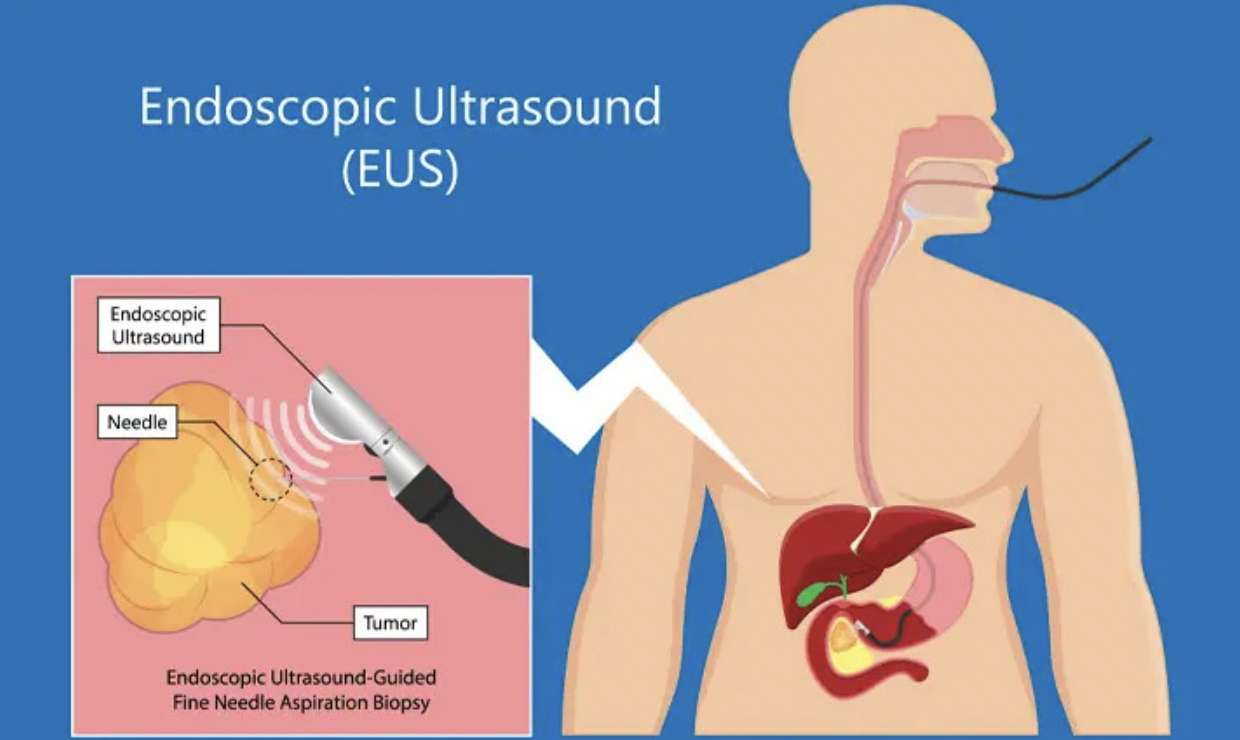Overview
An endoscopic ultrasound, also known as EUS, is a diagnostic test used to examine the inside of your digestive tract. It helps the healthcare professional detect cancers, including pancreatic cancer, colon cancer, and other cancers spreading to different parts of the body. Additionally, this test can also help detect inflammatory bowel disease, pancreatitis, and other conditions that may cause abdominal pain.
What is the EUS Test?

Endoscopic ultrasound test, or EUS, is a procedure that combines two diagnostic examinations — endoscopy and ultrasound. The former is a long, thin, and flexible tube with a camera and light on the end. The latter is a probe at the end of the endoscope that sends sound waves to produce images of the organs, tissues, and blood vessels. This test is primarily used to diagnose conditions affecting the digestive tract and nearby organs and tissues.
- The EUS tube placed down the throat captures images of the esophagus, stomach, and parts of the small intestine.
- The EUS tube is also placed through the anus to capture the images of the rectum and colon.
The findings of the EUS test are precise, which helps the doctor and their team plan the best treatment option for their patients.
Why is the EUS Test Done?
Healthcare providers use the EUS test to evaluate or diagnose the following conditions:
- Spread of the cancer in the body is also known as metastatic cancer.
- Lumps, lesions, or abnormal growths in the body.
- Digestive tract issues, including inflammatory bowel disease (IBD), colon cancer, and anal fissures.
- Gallbladder diseases, such as gallstones and gallbladder infection
- Lung diseases, such as lung cancer
- Pancreatic disease, such as pancreatic cancer, pancreatic cysts, and pancreatitis
- Swallowing disorders, such as Barrett’s esophagus.
When to See a Doctor?
It is advised to visit the doctor for the EUS test in the following instances. If you happen to reside in ashok vihar then Dr Anando Sengupta should be your go to option for EUS test in ashok vihar
- If you have been experiencing abdominal pain for a long time.
- The abdominal pain is accompanied by fever and chills.
- If you have been experiencing unexplained weight loss.
- For the evaluation of abnormalities, such as lumps and lesions that were detected at a previous endoscopy or seen on X-ray tests, such as a CT scan. In this situation, the EUS test provides a detailed image of the lump or lesion to confirm the diagnosis of cancer.
Procedure

Before
Before the procedure, your healthcare professional will give you some dos and don’ts instructions. They will adjust the dosage of your medication, such as blood thinners or insulin. You will be asked not to eat or drink for a specific period before the endoscopic ultrasound test. In case of a lower EUS procedure, your healthcare professional may also prescribe bowel prep, such as laxatives, to clean out the bowels.
During
Depending on your case, the healthcare professional will perform an upper or lower EUS test. Both procedures are outpatient procedures, and you will be allowed to go home the same day. You will be given an IV sedative. Its effects will numb your body and help you relax so that you don’t feel any pain or discomfort during the procedure. As you will be under sedation, the professional will ask you to bring someone to drive you home.
- Upper EUS: For the upper EUS test, the healthcare professional will place a plastic mouthguard in your mouth to protect the teeth and prevent biting down on the endoscope. They will insert the endoscope through the mouth, esophagus, and stomach until it reaches the duodenum. They will monitor the ultrasound images displayed on the screen and examine your upper digestive tract, nearby organs, cysts, and tumors. If required, they will use the ultrasound images to thread a thin needle through the endoscope to take a sample of the tissue or fluid. Towards the end, the endoscope will be gently removed.
- Lower EUS: In case of a lower EUS test, the healthcare professional will insert an ultrasound endoscope through your anus and rectum into the colon. They will look at the ultrasound images on the monitor to examine the lower digestive tract, nearby organs, cysts, and tumors. If required, they will take a sample of the tissue for biopsy. The endoscope will be gently removed to slowly wake you up.
After
The effects of sedation will wear off within 30 to 60 minutes. During this team, the care team will monitor your vitals. You may experience a sore throat after an upper EUS and gas or bloating after a lower EUS. However, these side effects will subside after 1-2 days. The doctor will advise you not to engage in any strenuous activity for the rest of the day.
Why Choose Us?
Dr. Anando Sengupta is a highly skilled gastroenterologist considered to be a skilled doctor to perform EUS in Ashok Vihar. With over years of experience in this field, the doctor and his team are the experts in performing all the diagnostic and therapeutic procedures. Each report of the test is carefully examined to identify the exact problems. Dr. Sengupta’s clinic is equipped with advanced equipment and the latest technology to ensure precise findings of the procedure.
The patient-centric approach of Dr. Anando Sengupta makes him the best healthcare professional for the EUS test in Ashok Vihar. From the diagnosis of the condition to its treatment, the doctor walks with you at every stage.
Frequently Asked Questions
The EUS test is used to diagnose various digestive abnormalities in the body, including certain cancers, inflammatory bowel disease, pancreatitis, cysts, and more.
The EUS test may become a little uncomfortable for patients. Therefore, the healthcare professionals give sedation to relax them before the procedure.
On average, the EUS test takes 30-60 minutes to complete. After the procedure, it takes another 60 minutes for the effects of sedation to wear off.




